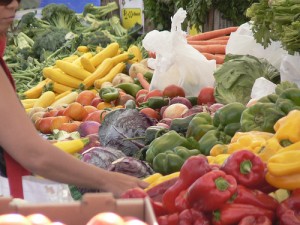 There are moments when I feel like reading a nutrition label is more like a science experiment. It’s come down to this…if I can’t understand it, I don’t buy it (generally…unless I’m having a craving!). We’ve managed to simplify our shopping routine simply by avoiding the following: high fructose corn syrup, hydrogenated oils, MSG, dyes, and trans fats. Eliminating those foods from our diet, a majority of the time, compels us to incorporate more whole foods into our diet. We also strive to buy organic (when we can afford it), local, sustainable foods. We shop at natural markets and the occasional farmer’s market.
There are moments when I feel like reading a nutrition label is more like a science experiment. It’s come down to this…if I can’t understand it, I don’t buy it (generally…unless I’m having a craving!). We’ve managed to simplify our shopping routine simply by avoiding the following: high fructose corn syrup, hydrogenated oils, MSG, dyes, and trans fats. Eliminating those foods from our diet, a majority of the time, compels us to incorporate more whole foods into our diet. We also strive to buy organic (when we can afford it), local, sustainable foods. We shop at natural markets and the occasional farmer’s market.
I’m frequently asked questions like, How do you eat so healthy? Isn’t it expensive? How do you know what to buy? Does it take a lot of time? Does it take a lot of research? Where do I begin? Eating this way has become second nature. I go to the store and don’t really think much about what I’m buying. I have already done the research on the brands…read the labels on their products. I know which foods are best for our particular family (given our allergies and intolerances). Ninety percent of the time, I can find a palatable, healthier alternative to conventional foods.
When I think back…way back to when I first started eating this way, I realize it was an adjustment. It did take some time to read labels and research companies. It was a bit overwhelming, particularly at conventional grocery stores. And very often, it’s more expensive (but so are doctor bills). So how does one begin to “green” their diet? Aracely, this post is for you!
 Buy organic. When you can. Yes, it’s typically more expensive. However, when you purchase 100% certified USDA organic foods, you know that they have been produced without synthetic growth hormones, genetically engineered organisms, antibiotics, chemical fertilizers or man made chemical pesticides. Choosing these foods will help you eliminate many, if not all of the ingredients listed above without having to read a single label. Admittedly, it can get quite expensive to buy all of your foods this way. So how do you decide which foods to purchase organic? I like to start with fruits and vegetables. These twelve fruits and veggies are the most likely to contain pesticide residue and should therefore be purchased “organic.” On the contrary, these fifteen fruits and veggies are less likely to be contaminated and can therefore be purchased conventionally.
Buy organic. When you can. Yes, it’s typically more expensive. However, when you purchase 100% certified USDA organic foods, you know that they have been produced without synthetic growth hormones, genetically engineered organisms, antibiotics, chemical fertilizers or man made chemical pesticides. Choosing these foods will help you eliminate many, if not all of the ingredients listed above without having to read a single label. Admittedly, it can get quite expensive to buy all of your foods this way. So how do you decide which foods to purchase organic? I like to start with fruits and vegetables. These twelve fruits and veggies are the most likely to contain pesticide residue and should therefore be purchased “organic.” On the contrary, these fifteen fruits and veggies are less likely to be contaminated and can therefore be purchased conventionally.
 Shop at the Farmer’s Market. If you can’t afford organic, shopping locally is really your best alternative. The face-to-face interaction with local growers and farmers allows you to ask questions about the types of pesticides and fertilizers used. You can have a discussion about the ingredients used in their foods. The foods are typically fresher since they have not had to travel distances to get to your local grocery store. You can find a local farmer’s market here. {Photo credit: Marc_Smith}
Shop at the Farmer’s Market. If you can’t afford organic, shopping locally is really your best alternative. The face-to-face interaction with local growers and farmers allows you to ask questions about the types of pesticides and fertilizers used. You can have a discussion about the ingredients used in their foods. The foods are typically fresher since they have not had to travel distances to get to your local grocery store. You can find a local farmer’s market here. {Photo credit: Marc_Smith}
Cook your own food. It wasn’t until my son was diagnosed with food allergies, that I realized how little control and options we have when we eat out. And eating out is always more expensive. Cooking your own food allows you to control how much food you are cooking (which means yay or nay on leftovers) which also helps with portion control (and weight management). Eating at home also gives you control over the ingredients used in your food. Want more veggies and whole grains? Less sodium, fat, and calories? More time to digest your food? More time with your family? Eat in!
Eat whole foods. The less processed the food, the better it is for you. It’s really that simple. Processed foods typically contain more sodium, fat, calories, and sugar than whole foods. They are often lacking in fiber, whole grains, good fat, antioxidants and other nutrients your body needs. And, they also contain ingredients designed to extend their shelf life…ingredients that are foreign to our body like artificial colors, flavors, preservatives, and chemicals.
Read labels with a discerning eye. Unfortunately, terms such as “all-natural” and “free range” are not regulated. Look beyond those labels to determine if the food is one you want to eat (hormone-free, devoid of trans fats, etc.). Opt for “fair trade,” 100% organic, and certified which tend to be more meaninful.
No compensation was received for this post.
- Discover Luxury at Sonesta Irvine: Your Ideal Staycation - August 8, 2024
- CHOC Walk Returns to the Disneyland Resort – Special Events and Ways to Support - June 28, 2023
- Beastly Ball Returns to the Los Angeles Zoo - May 8, 2023

Leave a Reply